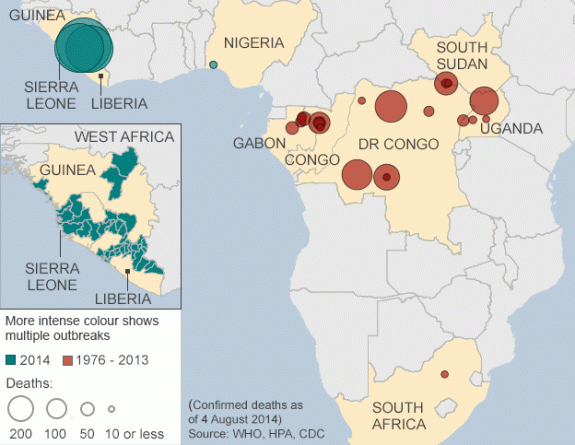
Scientists believe that the first patient in the recent Ebola outbreak was a 2-year-old boy from a village in Guéckédou, in southeastern Guinea, the New York Times reports. This finding is the result of an extensive investigation carried out by international researchers.
The young child died on Dec. 6, just a few days after falling ill. Seven days later, his mother died too, followed by his grandmother and three-year-old sister, who fell sick on Christmas Day and was dead before she could see the New Year. Their symptoms included fevers, vomiting and diarrhea, but no one was sure how they fell ill or what the disease was.
As I’ve mentioned previously, the three main countries involved in the outbreak — Sierra Leone, Guinea, and Liberia — and the newly involved country of Nigeria, which has just announced their first cases, are completely unfamiliar with Ebola. Until recently, the virus had never before reached that part of Africa; prior outbreaks were confined to the central and southwestern African nations of Uganda, Gabon, South Sudan, and the Democratic Republic of the Congo:

Until March 2014, Ebola was largely confined to four countries in central and southwestern Africa, with a few exceptions for travelers and isolated cases. Now, the virus has reached an entirely new region of the continent.
West Africa’s unfamiliarity with the disease explains why alarm bells didn’t go off immediately upon the first reports of symptoms. Unfortunately, because no one initially suspected Ebola, the virus had several weeks (at least) to spread freely among families, neighbors, and communities.
Further assisting in the spread of the virus was the location of the initial outbreak. The town of Guéckédou, where scientists believe the first case emerged, is at the intersection of Sierra Leone, Liberia, and Guinea, giving the disease direct access into all three countries.

Scientists think the current Ebola outbreak originated in Guéckédou (marked on the map above), which is located in southeastern Guinea, right by the borders with Sierra Leone and Liberia.
Scientists believe that two people who attended the boy’s grandmother’s funeral contracted Ebola and transported it back to their villages. A health worker who had cared for the dying patients carried it to his village, where both he and his doctor died, the Times reports.
From there, relatives of the sick who visited from neighboring towns became infected and brought the disease back with them. When Ebola was first recognized in March, people throughout eight Guinean communities had contracted and died from the virus. Meanwhile, other cases were already popping up in Liberia and Sierra Leone.
It is not yet clear how the 2-year-old boy contracted Ebola, or how the virus found its way to the region. It infects monkeys and apes, and prior outbreaks are through to have been caused by someone exposed to an infected animal’s blood while killing or butchering it. The Times notes that some researchers also think that people can become infected by eating fruit or other uncooked foods contaminated by droppings from infected bats.
Once a person becomes ill, they can easily spread the virus through their bodily fluids; as the illness progresses, it becomes even easier to infect others. This outbreak is thought to have spread so quickly due to an increase in urbanization. Previous outbreaks were better contained because the virus was isolated to specific areas, but as cities become more gentrified, there is an increase in travel between towns and villages.
Liberia, Sierra Leone, and Guinea are among the world’s poorest countries, and are recovering from decades of political corruption and civil war. Even if they had suspected Ebola right away, the health care system was vastly underprepared for such an outbreak and could have done little to stop it. According to the Times, “hospitals in the region often lack running water and gloves, and can be fertile ground for epidemics.” At one clinic in Guinea, “the treatment room was poorly lit and had no sink. There were few buckets of chlorine solution, and the staff found it impossible to clean their hands between patients.”
A spokesman for the World Health Organization, Gregory Hartl, said that some towns did not cooperate with regulars early on. “Early on in the outbreak, we had at least 26 villages or little towns that would not cooperate with responders in terms of letting people into the village, even,” said Hartl.
The outbreak occurred in three waves: “The first two were relatively small, and the third, starting about a month ago, was much larger,” Mr. Hartl said. “That third wave was a clarion call,” he said.
